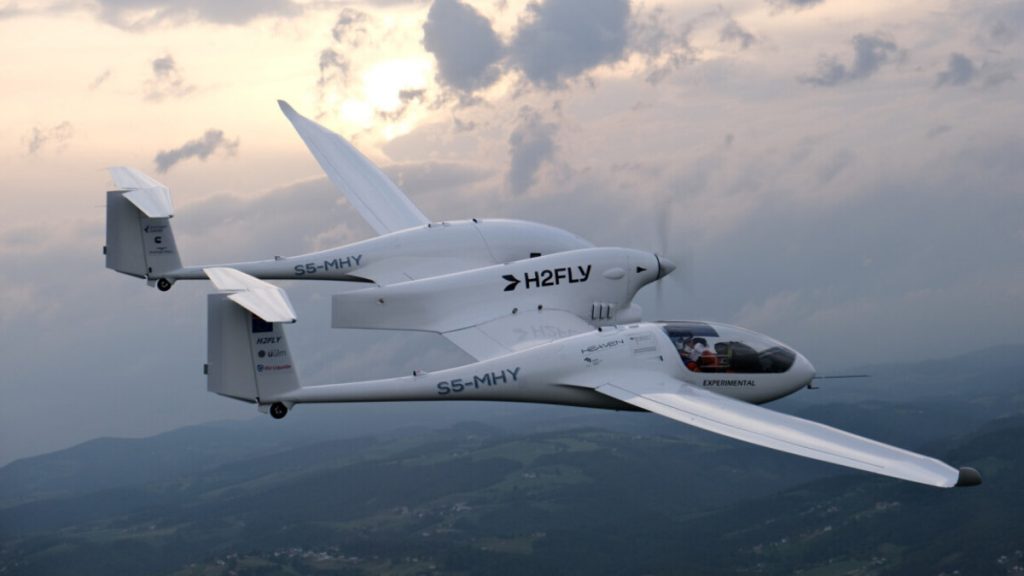In a small airport in Maribor, Slovenia, H2FLY, a German hydrogen propulsion startup, has achieved a significant milestone in zero-emission aviation. They recently completed the world’s first crewed flights powered solely by liquid hydrogen.
While some might recall the Soviets’ experiment with liquid hydrogen as fuel 35 years ago, it’s important to note that they only used it for one of three engines. In contrast, H2FLY’s HY4 aircraft operates exclusively on liquid hydrogen, relying entirely on a hydrogen fuel-cell powertrain for the entire flight.
A recent test flight marked the culmination of Project HEAVEN—an EU-funded initiative demonstrating the feasibility of using cryogenic liquid hydrogen in aircraft. This project, short for High power density FC System for Aerial Passenger Vehicle fueled by liquid HydrogeN, showcased H2FLY’s breakthrough.
During the latest test flight, which lasted around ten minutes, the HY4 and its two pilots achieved an impressive 3-hour flight a few days prior, consuming 10kg of hydrogen. With its full 24kg storage capacity, the aircraft could sustain flight for up to 8 hours.
“It feels really amazing, it is the perfect teamwork coming to life,” said one of the pilots, Johannes Garbino-Anton, after the flight. He added that the technology “works perfectly,” and that the biggest difference to a normal aircraft is the lack of vibrations and noise. And, the lack of carbon dioxide emissions.
H2FLY’s propulsion system comprises hydrogen storage, a 120kW fuel-cell energy converter, and an electric engine. This summer’s achievement involved operating the plane with liquid hydrogen, which is more energy-dense than gaseous hydrogen. This choice allows for smaller and lighter fuel tanks, preserving passenger seating and cargo space.
Moreover, liquid hydrogen significantly extends the flight range. The HY4 test aircraft, for instance, can cover 750km with gaseous hydrogen but doubles that distance, reaching 1,500km, with liquid hydrogen. However, handling liquid hydrogen requires cryogenic temperatures of around -253°C, adding complexity to transportation and refueling.
It’s worth noting that the HY4 aircraft, made of glass fiber and carbon fiber, does not have plans for commercial production. Instead, H2FLY’s next objective is to scale the fuel-cell system to a megawatt capacity, known as the H2F-175 system, enabling longer flights and higher altitudes, up to 27,000 feet. Collaborating with Deutsche Aircraft, they plan to retrofit a 30-seat Dornier 328 demonstrator with H2FLY’s hydrogen-electric fuel cells, starting test flights by 2025.
Dr. Josef Kallo, H2FLY’s CEO, envisions that by the end of the decade, this upscaled system could power a 40-seat regional plane with a range of approximately 2,000km. He believes it’s a matter of resources and time and suggests it could even pave the way for 4MW+4MW powertrains to propel larger aircraft for 80 to 100 passengers. Furthermore, he does not rule out entirely new aircraft designs, such as blended wing body concepts, from different manufacturers.
“As an engineer, I can say that a 40-seater hydrogen-powered plane is a question of money and time. After that it becomes visionary,” Kallo stated.
The future of clean-burning, hydrogen-powered aviation hinges not only on the fuel itself but also on the development of robust refueling infrastructure. H2FLY has been collaborating with Air Liquide to address this need.
“I cannot stress the importance of achievement in terms of the technology itself,” said Marco Rizzatto, flight test engineer at Pipistrel Vertical Solutions, who supported the integration of the cryogenic fuel tank. “Liquid hydrogen has the potential to be a game-changer for commercial aviation.”
Founded in 2015 by engineers from the German Aerospace Center in Stuttgart and the University of Ulm, H2FLY focuses on the development of propulsion systems and individual components. In 2021, the company was acquired by Joby Aviation, a California-based enterprise dedicated to developing electric vertical take-off and landing vehicles (eVTOLs) for air taxi services.

